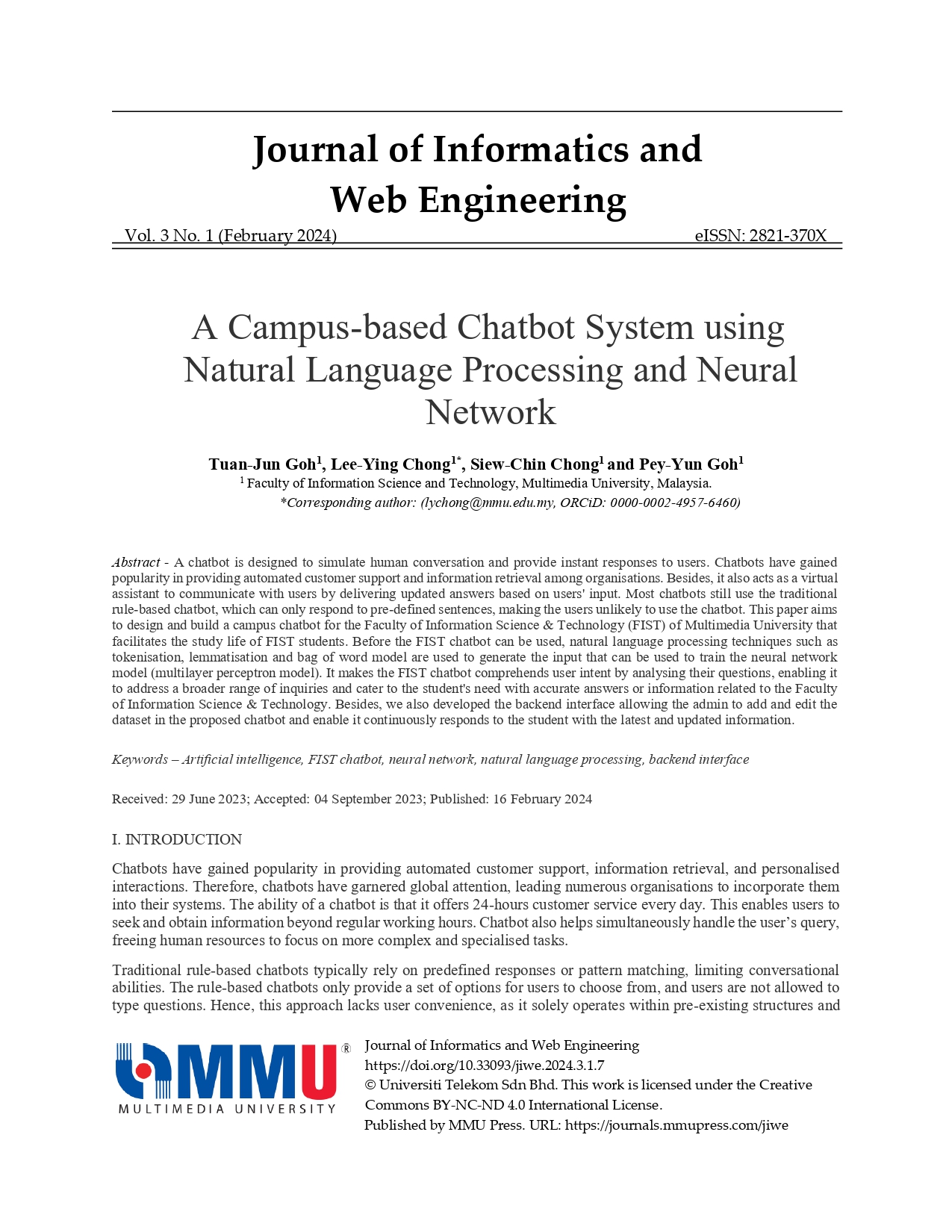A Campus-based Chatbot System using Natural Language Processing and Neural Network
Main Article Content
Abstract
A chatbot is designed to simulate human conversation and provide instant responses to users. Chatbots have gained popularity in providing automated customer support and information retrieval among organisations. Besides, it also acts as a virtual assistant to communicate with users by delivering updated answers based on users' input. Most chatbots still use the traditional rule-based chatbot, which can only respond to pre-defined sentences, making the users unlikely to use the chatbot. This paper aims to design and build a campus chatbot for the Faculty of Information Science & Technology (FIST) of Multimedia University that facilitates the study life of FIST students. Before the FIST chatbot can be used, natural language processing techniques such as tokenisation, lemmatisation and bag of word model are used to generate the input that can be used to train the neural network model (multilayer perceptron model). It makes the FIST chatbot comprehends user intent by analysing their questions, enabling it to address a broader range of inquiries and cater to the student's need with accurate answers or information related to the Faculty of Information Science & Technology. Besides, we also developed the backend interface allowing the admin to add and edit the dataset in the proposed chatbot and enable it continuously responds to the student with the latest and updated information.
Article Details

This work is licensed under a Creative Commons Attribution-NonCommercial-NoDerivatives 4.0 International License.
All articles published in JIWE are licensed under a Creative Commons Attribution-NonCommercial-NoDerivatives 4.0 International (CC BY-NC-ND 4.0) License. Readers are allowed to
- Share — copy and redistribute the material in any medium or format under the following conditions:
- Attribution — You must give appropriate credit, provide a link to the license, and indicate if changes were made. You may do so in any reasonable manner, but not in any way that suggests the licensor endorses you or your use;
- NonCommercial — You may not use the material for commercial purposes;
- NoDerivatives — If you remix, transform, or build upon the material, you may not distribute the modified material.
References
J. Alburger, “Rule-Based Chatbots vs. AI Chatbots: Key Differences,” Hubtype, 2018, [Online] Available: https://www.hubtype.com/blog/rule-based-chatbots-vs-ai-chatbots
M. Ekerin Oluseye, H. . Tan Yeen-Ju, and T. K. Neo, “Exploring the Use of Immersive Technology in Education to Bring Abstract Theoretical Concepts to Life,” International Journal of Creative Multimedia (IJCM), vol. 1, no. SI 1, pp. 71–81, Jun. 2020.
MY. Xin, L. W. Ang and S. Palaniappan, "A Data Augmented Method for Plant Disease Leaf Image Recognition based on Enhanced GAN Model Network," Journal of Informatics and Web Engineering (JIWE), vol. 2, no. 1, March 2023.
J. Kengam, “Artificial Intelligence in Education,” UK, 2020, doi:10.13140/RG.2.2.16375.65445.
P. Das, “How do Chatbots transform the traditional education process?” Linkedin, 2021, [Online] Available: https://www.linkedin.com/pulse/how-do-chatbots-transform-traditional-education-process-poulami-das?trk=public_profile_article_
Kuhail, M. A., Alturki, N., Alramlawi, S., and Alhejori, K., “Interacting with educational chatbots: A systematic review,” Education and Information Technologies, Dubai, 2022, pp. 1–46, doi:10.1007/s10639-022-11177-3.
S. Singh, “Machine Learning Algorithms for teaching AI Chatbots,” Linkedin, 2022, [Online] Available: https://www.linkedin.com/pulse/machine-learning-algorithms-teaching-ai-chatbots-sreeshti-singh?trk=pulse-article_more-articles_related-content-card
harkiran, “What are the Advantages and Disadvantages of Chatbots in Business?” GeeksforGeeks, 2022, [Online] Available: https://www.geeksforgeeks.org/what-are-the-advantages-and-disadvantages-of-chatbots-in-business/ (Accessed at 15 Nov2022)
Towardsai, “How to Build and Train Your First Neural Network. Towards AI, 2020,” [Online] Available: https://towardsai.net/p/machine-learning/how-to-build-and-train-your-first-neural-network-9a07d020c4bb
C. -H. Lee, T. -Y. Chen, L. -P. Chen, P. -C. Yang and R. T. -H. Tsai, "Automatic Question Generation from Children’s Stories for Companion Chatbot," 2018 IEEE International Conference on Information Reuse and Integration (IRI), USA, 2018, pp. 491-494, doi: 10.1109/IRI.2018.00078.
S. -H. Wu, L. -P. Chen, P. -C. Yang and T. Ku, "Automatic Dialogue Template Synthesis for Chatbot by Story Information Extraction," 2018 IEEE International Conference on Information Reuse and Integration (IRI), USA, 2018, pp. 485-490, doi: 10.1109/IRI.2018.00077.
M. -H. Su, C. -H. Wu, K. -Y. Huang, Q. -B. Hong and H. -M. Wang, "A chatbot using LSTM-based multi-layer embedding for elderly care," 2017 International Conference on Orange Technologies (ICOT), Singapore, 2017, pp. 70-74, doi: 10.1109/ICOT.2017.8336091.
S. Gupta, and Y. Chen, “Supporting Inclusive Learning Using Chatbots? A Chatbot-Led Interview Study,” Journal of Information Systems Education, 33(1), pp. 98-108, 2022.
Engati, “Education chatbot template,” 2023, [Online] Available: https://www.engati.com/chatbot-templates/education-chatbot-template
TARS, Undergraduate Admissions Chatbot, 2023, [Online] Available: https://hellotars.com/chatbot-templates/education/NJ3Xw_/undergraduate-admissions-chatbot
Multimedia University, Facebook Messenger, 2023, [Online] Available: https://www.facebook.com/messages/t/177972935645757
I. Rotaru, “How do chatbots work? Chatbot architecture and algorithms,” chatfuel, 2023, [Online] Available: https://chatfuel.com/blog/how-do-chatbots-work
N. Srivastava, “Machine Learning Algorithms for teaching AI Chatbots,” E2ECloud, 2022, [Online] Available: https://www.e2enetworks.com/blog/machine-learning-algorithms-for-teaching-ai-chatbots

